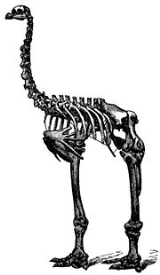
Pachyornis
Encyclopedia
Pachyornis is an extinct genus
of ratite
s from New Zealand
which belonged to the moa
family. Like all ratite
s it was a member of the order
Struthioniformes. The Struthioniformes are flightless birds with a sternum
without a keel. They also have a distinctive palate
. This genus contains 2 species, and are part of the Anomalopteryginae or lesser moa subfamily. Pachyornis moa were the stoutest and most heavy-legged genus of the family. The most notable species being Pachyornis elephantopus - the Heavy-Footed Moa. They were generally similar to the Eastern Moa
or the Broad-billed moa of the genus Euryapteryx, but differed in having a pointed bill and being more heavyset in general. At least one species (P. australis) is assumed to have had a crest of long feathers on its head. The species became rapidly extinct following human colonization of New Zealand, with the possible exception of P. australis, which may have already been extinct by then.
Two new genetic lineages, which may eventually be described as new species, are now known to have existed, one each from New Zealand's North and South Island.
Genus
In biology, a genus is a low-level taxonomic rank used in the biological classification of living and fossil organisms, which is an example of definition by genus and differentia...
of ratite
Ratite
A ratite is any of a diverse group of large, flightless birds of Gondwanan origin, most of them now extinct. Unlike other flightless birds, the ratites have no keel on their sternum—hence the name from the Latin ratis...
s from New Zealand
New Zealand
New Zealand is an island country in the south-western Pacific Ocean comprising two main landmasses and numerous smaller islands. The country is situated some east of Australia across the Tasman Sea, and roughly south of the Pacific island nations of New Caledonia, Fiji, and Tonga...
which belonged to the moa
Moa
The moa were eleven species of flightless birds endemic to New Zealand. The two largest species, Dinornis robustus and Dinornis novaezelandiae, reached about in height with neck outstretched, and weighed about ....
family. Like all ratite
Ratite
A ratite is any of a diverse group of large, flightless birds of Gondwanan origin, most of them now extinct. Unlike other flightless birds, the ratites have no keel on their sternum—hence the name from the Latin ratis...
s it was a member of the order
Order (biology)
In scientific classification used in biology, the order is# a taxonomic rank used in the classification of organisms. Other well-known ranks are life, domain, kingdom, phylum, class, family, genus, and species, with order fitting in between class and family...
Struthioniformes. The Struthioniformes are flightless birds with a sternum
Sternum
The sternum or breastbone is a long flat bony plate shaped like a capital "T" located anteriorly to the heart in the center of the thorax...
without a keel. They also have a distinctive palate
Palate
The palate is the roof of the mouth in humans and other mammals. It separates the oral cavity from the nasal cavity. A similar structure is found in crocodilians, but, in most other tetrapods, the oral and nasal cavities are not truly separate. The palate is divided into two parts, the anterior...
. This genus contains 2 species, and are part of the Anomalopteryginae or lesser moa subfamily. Pachyornis moa were the stoutest and most heavy-legged genus of the family. The most notable species being Pachyornis elephantopus - the Heavy-Footed Moa. They were generally similar to the Eastern Moa
Eastern moa
The Eastern Moa, Emeus crassus, is an extinct species of moa. When the first specimens were originally described by Richard Owen, they were placed within the genus Dinornis as three different species, but, was later split off into their own genus, Emeus. E. crassus is currently the only species of...
or the Broad-billed moa of the genus Euryapteryx, but differed in having a pointed bill and being more heavyset in general. At least one species (P. australis) is assumed to have had a crest of long feathers on its head. The species became rapidly extinct following human colonization of New Zealand, with the possible exception of P. australis, which may have already been extinct by then.
Two new genetic lineages, which may eventually be described as new species, are now known to have existed, one each from New Zealand's North and South Island.
Species
- Pachyornis elephantopus Heavy-footed Moa
- Pachyornis australis Crested Moa
- Pachyornis mappini Mappin's Moa
- Pachyornis new lineage A (undescribed taxon)
- Pachyornis new lineage B (undescribed taxon)

